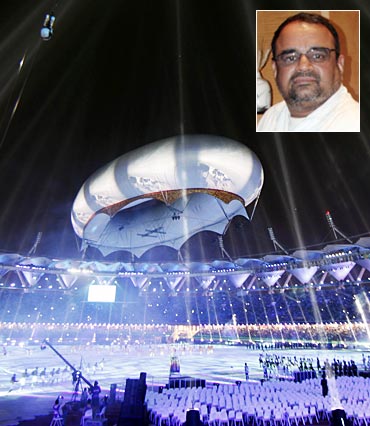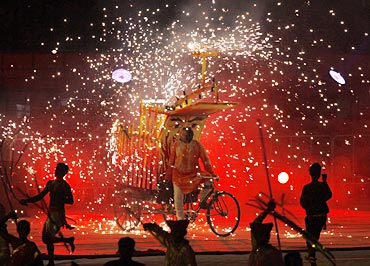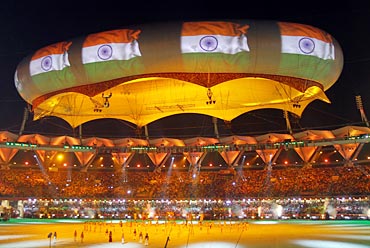
He will sip his morning coffee sitting in the restaurant of a hotel that has been his home for the last few weeks and look forward to the day that stretches before him -- empty and with absolutely no activity.
Then he will head to Mumbai, take a day off and start work on his movie.
"It is too early to speak about it," he tells you over the phone from New Delhi, sounding far more relaxed than the last time we spoke. "Give me a week or two. We start pre-production beginning of next month."
In the year-and-a-half that filmmaker Bharat Bala was associated with the Commonwealth Games ceremonies, everything else had taken a back seat.
During this time, he says he could have made 'a film-and-a-half'. But organising the Games ceremonies was an experience he will cherish the most.

Bala sees it as something of following the footsteps of his idol Zhang Yimou, the Chinese filmmaker and the creative director of the Beijing Olympics's opening ceremony.
"This was a fantastic opportunity. It was exciting because I did for India what Yimou did for China and what Danny Boyle will do for England (when London stages the 2012 Olympics)!" he says excitedly.
Bala's opening ceremony earned much accolades across the world and provided a much-needed boost to India's morale.
The closing ceremony -- that featured a host of Bollywood musicians, martial artists from various Indian states, 2010 children who danced to Vande Mataram and a few thousand more dancers -- was a far less a grand affair.
Yet putting this up was a challenge in itself.
"We got possession of the venue (the Jawaharlal Nehru Stadium) in the early hours of October 13. This was because the track and field events came to a close on October 12."
"The Aerostat itself takes about 20 hours to be airborne. Then there were lights, lasers and ground protection that needed to be put in place. It was only around the morning of October 14 that the entire cast simply got an orientation of the ground. Till then we were rehearsing in a simulated environment at the parade grounds. It was a close call."

Even within these teams, different groups had different timings for the rehearsals. For instance, the Vande Mataram segment had 2,010 children. These children would practice in batches and come together as a team.
While the paucity of time was one of the biggest hurdles in the way of putting together the closing ceremony, Bala feels the opening ceremony was far more challenging since it was far bigger and much more anticipated.
The success of the opening ceremony put Bala and his team on the front foot and "gave us a much-needed adrenalin rush."
It also inspired a lot of confidence within the Indian government which allowed Bala and his team to use a helicopter-mounted camera.

Bala, who was less than happy with Doordarshan's coverage of the opening ceremony, was cooped up in the broadcast compound outside the Jawaharlal Nehru stadium on the evening of October 14, supervising the final mixing during the closing ceremony.
"It was important to capture the conceptual idea, the various formations, highlights of the martial arts and the colours during Vande Mataram," he says adding that Doordarshan did "a far superior job" the second time around.
Doordarshan also ran a commercial-free telecast of the closing ceremony unlike the ad-ridden opening ceremony.
The closing ceremony, whose theme was Universal Love, started with a spectacular display of martial arts from various parts of the country.

"The idea was to start by showing the cultural heritage of the country and move towards a more contemporary display."
This was where the laser-show and the segment featuring some of the top names from Bollywood music came in.
Usha Uthup, Ila Arun, Zilla Khan, Shubha Mudgal, Sukhwinder Singh, Shankar Mahadevan with his mater Ehsaan Noorani and Loy Mendonsa, Shaan, Kailash Kher and Sunidhi Chauhan were among those who sang, as did Shiamak Davar, better known for his choreography.
Davar sang international songs like Queen's We Will Rock You and I Gotta Feeling while Sunidhi Chauhan and Shankar Mahadevan sang Desi Girl.
The segment that had assorted musical numbers seemed like it was rather loosely put together with no binding theme or a specific flow.
Bala defends this, saying, "You have to remember we were addressing a global audience. Some of the Hindi songs were universal in their appeal and the English ones were timeless."
"When you sing We Will Rock You at the right time, it can have tremendous effect."
Image: Congress President Sonia Gandhi, Prime Minister Manmohan Singh and wife Gursharan Kaur, Vice-President Hamid Ansari and Britain's Prince Edward.

"A large part of the credit for the success of the ceremonies and the Games goes to the people of Delhi," he adds.
"I happened to attend the track and field event where we won. They played Maa Tujhe Salaam at the stadium and the crowd went berserk!"
"Even during the ceremonies, the energy of the crowd was amazing. During the closing ceremony, all we had to do was distribute 1,000 flags to the people as they walked in (since they were not allowed to carry anything inside). Having watched the cricket fever, we felt the tricolour would add to the patriotic fervour. And it did!"
"To create unique national pride gives me a high. I did not make any films in these 18 months, but I got an experience that was far bigger."

"He said it (the ceremony) was a great unifying factor for India when the entire audience came together and that the one thing he would take back would be the sense of national pride in the stadium. I felt that was a moving thought," adds Bala.
When I quote a tweet by a prominent journalist who dismissed the ceremony as one that had 'total absence of sophisticated thought', he responds, "You must understand that the closing ceremony is supposed to be free flowing and not formal."
"There isn't any protocol. It is a moment of celebration where the atmosphere and mood are the winners. People told me that they felt the ceremony culminated well. They felt high and great when they walked out."
"The challenge for us had been to put together something that appealed to the West but more importantly got Indians inspired."
And this is something Bala feels he has achieved.
Back in New Delhi, the Aerostat will be deflated and packed away. Volunteers will shake hands and promises of meeting again will be made.
The city will return to its humdrum existence. But the talk of two glittering ceremonies that changed the perception of perhaps the worst-ever pre-Games disaster will continue for months to come.
The man who made it all happen will be in his snug office in south Mumbai planning the pre-production schedule for his next film.